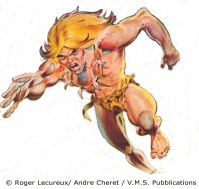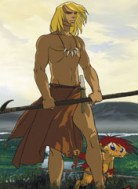Rahan (the comic)

The comic | Original title: Money
Film script: Roger Lecureux, Jean-François Lecureux
Drawings: Andre Cheret, Zam, DeHuescar and Enrique Romeroe
Publishers:
VMS Publications | Country: France
Year: 1969
Gender: Cartoon adventure
Periodicity: Monthly
Recommended age: Comic strip for everyone | Rahan is a 1969 French comic that tells the story of a prehistoric man with great intellectual abilities. The stories were initially written by Roger Lecureux and later, following his death, by his son Jean-François Lecureux. Homeland of great artists, this comic can also count on valid artists such as Andre Cheret (who drew most of the work), closely followed by colleagues such as Zam, DeHuescar and Enrique Romero). The drawings of these artists make the whole work a must have for collectors, especially those who appreciate French works (see the comics of the great master Moebius). As for the story and the wild setting, it must be said immediately that the character of Rahan can be compared to other great characters of literature, such as Tarzan and Conan, even if the similarities stop only in an apparent context. In 1998 a limited version was published containing the most important stories and some preparatory sketches, as well as an interview with the publisher, while more recently some volumes have also been made available through the electronic e-book market. The story takes place in an unspecified prehistoric period and tells the story of the young Rahan, in the period following the destruction of his tribe due to the eruption of a volcano. The basic concept of the story lies in telling the protagonist's journey, through new and different lands, accompanying us to the discovery of new tribes and different lifestyles, certainly the aspect that most fascinates the reader during the progress of the adventure. . The teachings that Rahan carries around with him derive from the words that his father-great Crao said to him before he died and from his teachings: during one of his first adventures, Crao gives him a necklace with a bear's claw, representing courage, justice, generosity, altruism and piety. These are all the key points that serve to define the good character of Rahan, which make him a character with a moral stature, superior to many other supporting characters in the series. After the wedding, moreover, he receives another claw, that of curiosity. During his travels, Rahan will try to explain the strange events of the time (such as natural events) with his own method, almost scientific, trying to help the various tribes he meets along his path and including animals in difficulty.
Often using his knowledge and materials found around, he finds himself building a series of tools that will help him cope with various tasks: he will try to build fishing nets, catapults, magnifying glasses and so on. This too is an element that certainly differentiates it from other stories set in the same historical period, taking it to a different level. Rahan therefore stands as a leader capable of facing the most difficult missions, bringing his wisdom to the then known world. In 1986, Rahan was adapted for a television series and in 2006 a film directed by Christope Gans, starring Mark Decascos, was even produced, without achieving the desired results. After all, the story is not easy to adapt to the big screen and more effort would have been required by the producers. Rahan, the animated series

ï ¿½
2008 Xilam Animation / Castelrosso / Rai Fiction |
Original title: Money
Characters: Rahan, Ursus, Noama, Tetya, Enok, Sanga, Daro, Mogo, Draka
Authors: Roger Lecureux, Andr Ch ret
Production:
Xilam, Rai Fiction, Castelrosso Films
Directed by: Pascal Morelli
| Country: France, Italy
Year: 2009
Broadcast in Italy: 2009
Gender: Adventure
Episodes: 26
Duration: 26 minutes
Recommended age: Children from 6 to 12 years old | In 2009 a new 2D TV series based on the story of Rahan is announced, but with some corrections that slightly differentiate it from the comic book character: in the comic there is no magic, which turns out to be just a false myth arising from ignorance of the population of the time, while in the TV series, there is really a wizard, Rahan's enemy, who uses magical elements.
In the comic Rahan makes all his travels alone, while in the TV series he is accompanied by a small creature, almost a monster that remembers the gremlins from afar, who accompanies him on his travels. The creature perhaps clashes slightly with the realistic genre he wanted to take on the series, but still gives some fun moments. The structure of the comic included many mini-stories while in the TV series it was obviously necessary to resort to the creation of a single story divided into the various episodes. As for the particularities of the TV series, the first was certainly characterized by a more realistic style, even if more sketchy and not too accurate: let's say it was a good production for the time and certainly remembered the cousin Tarzan, at least as regards the design of certain costumes and settings. The new cartoon instead brings with it a new style, deriving in part from the influence of Japanese (and partly American) animation: the animations are more accurate, the more angular lines and the more vivid colors, certainly also suitable for an audience. of children. It is no coincidence that the TV series is broadcast Saturdays on Rai Due at 7,55 hours suitable for an audience of children.

ï ¿½
2008 Xilam Animation / Castelrosso / Rai Fiction |
The blonde protagonist then alternates with other cartoons bringing his adventure revisited in a modern key to the current audience, not disfiguring in the midst of so much competition (and it is a positive thing considering how "old" the original story from which it is drawn is).
The little monster that follows him on his adventures, called Ursus, is a bear transformed by the queen of shadows into this little being and is able to speak, therefore actively communicate, with Rahan. Ursus follows the protagonist with the hope that this will help him heal and return to his old form. The presentation of the new television took place at the Mipcom Jr festival in Cannes and was created by Pascal Morelli and co-produced by Rai-Fiction, Castelrosso Film and Xilam. In original, the title of the tv series is Rahan: Son Of The Dark Age.
The CEO of Xilam Animation himself, Marc du Pontavice, defined it in an interview with the Television Business Intrernational, a genre of story divided into three distinct parts: an epic adventure with a prehistoric setting, a comedy based on the controversial relationship between Rahan and Ursus and the protagonists' relationship with the tribes they will meet.

ï ¿½
2008 Xilam Animation / Castelrosso / Rai Fiction |
Note how the Rahan of the TV series looks younger than his comics counterpart, actually being only seventeen. On the one hand, this serves to propose the series as a product aimed at the children's audience, but on the other hand it still serves as a basis for the old fans of the series who will rediscover the aspects that made the comic famous. This Rahan is in fact young, but he maintains the ideals and skills that made him one of the best men of the time. The TV series of the 80s in this sense perhaps would have had to learn by proposing a more mature character, but concentrating most of the stories on the action rather than on the psychology of the protagonist. The absence of a shoulder then made the journey something different, like a challenge against himself that led Rahan to discover new places, while in the modern series, Rahan is led into trouble also because of the sense of responsibility he feels. towards Ursus who, as we said before, found (perhaps) his savior in Rahan.
As an element common to both series it must be said that I am absolutely against violence which is wisely dosed. Even if some characters will resort to force, often those who know how to use the intellect will prevail. This is perhaps the teaching that the authors wanted to give in the 60s and represents the cornerstone of the series (both comic and television).

ï ¿½
2008 Xilam Animation / Castelrosso / Rai Fiction |
The style may have modernized the character, leading him to confront himself with Japanese productions, even if the European style stands out precisely for the characterization of the people: in manga we often find ourselves in front of stories with a lot of action, also very well designed, but which lacks the essence of the characters who then find themselves fighting against unlikely enemies, only to make a flat story spectacular. In Rahan, the exact opposite happens, making him, contrary to appearances, a mature and pleasant character to follow. In conclusion, it is certainly a story to be appreciated that will make viewers retrace the history of humanity, whether new or old fans, but certainly an excellent opportunity to enjoy a story that in the end will give moments of reflection, an element absent in perhaps too many productions that make special effects their strong point, but that lead the new generations to follow characters who are increasingly empty and led to violence as an end in itself. The images of the animated series Rahan are copyright
2008 Xilam Animation / Castelrosso / Rai Fiction
The images of Rahan's comic are copyright Roger Lecureux / Andre Cheret / VMS Publications |

